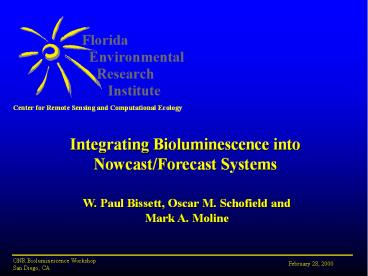ONR Bioluminescence Workshop - PowerPoint PPT Presentation
Title:
ONR Bioluminescence Workshop
Description:
Center for Remote Sensing and Computational Ecology ... G. breve. Tricho-desmium. Benthic Flora. Synecho- coccus. Relict. DOM. Predator. Closure ... – PowerPoint PPT presentation
Number of Views:222
Avg rating:3.0/5.0
Title: ONR Bioluminescence Workshop
1
Integrating Bioluminescence into Nowcast/Forecast
Systems
- W. Paul Bissett, Oscar M. Schofield and Mark A.
Moline
2
Issues
- How do we couple observational nowcast/forecast
systems with bioluminescence sensors to yield - 1) a framework for when and where to deploy
detection systems? - 2) detection avoidance maps?
3
IOPs, AOPs, and Ocean Color
4
HyCODE Application Scenarios
Satellite ocean sensors - NEMO - SeaWiFS -
AVHRR
Remote sensing products Sensor performance Environ
ment Prediction
Imagery
Aircraft sensors - Hyperspectral - Lidar
In Situ Data
Mission Planning Sampling Strategy
Expendable sensors
Underwater imaging systems - Mine ID - Benthic
characterization
Autonomous Sampling Networks - Environmental
characterization - Communication
5
Light Propagation in EcoSim
For each depth interval
light attenuation c(l,t) a(l,t) b(l,t)
absorption a(l,t) awater(l) aphyto(l)
aCDOM(l) ased(l)
scattering b(l,t) bwater(l) bphyto(l)
bCDOM(l) bsed(l)
backscattering bb(l,t) bb,water(l)
bb,phyto(l) bb,CDOM(l) bb,sed(l)
geometric structure of light md(l) fxnb(l,t),c
(l ,t), m0(l)
diffuse light attenuation Kd(l) a(l,t) bb(l
,t)/md(l)
water leaving radiance to a satellite Lu(l)
fxna(l,t),b(l ,t), bb(l ,t),Ed(l,t), md(l),
md(l), mu(l)
6
EcoSim 2.0 Model Formulation
Air/Sea CO2
Dust
Physical Mixing and Advection
Light
N2
Iron
NH4
NO3
CO2
PO4
SiO4
Relict DOM
Cocco-litho-phores
Benthic Flora
Dino- flagellate
Pelagic Diatoms
Tricho-desmium
Synecho- coccus
G. breve
Excreted DOM
Lysed DOM
Hetero- Flagellet
Copepod
Ciliates
Viruses
Bacteria
Sediment Detritus
Predator Closure
7
IOPs, AOPs, and Ocean Color
8
EcoSim 2.0 Model Formulation
Air/Sea CO2
Dust
Physical Mixing and Advection
Light
N2
Iron
NH4
NO3
CO2
PO4
SiO4
Relict DOM
Cocco-litho-phores
Benthic Flora
Dino- flagellate
Pelagic Diatoms
Tricho-desmium
Synecho- coccus
G. breve
Excreted DOM
Lysed DOM
Hetero- Flagellet
Ctenp- phores
Copepod
Ciliates
Viruses
Bacteria
Sediment Detritus
Predator Closure
9
Bioluminescent Light Propagation in EcoSim
For each depth interval
light attenuation c(l,t) a(l,t) b(l,t)
absorption a(l,t) awater(l) aphyto(l)
aCDOM(l) ased(l)
scattering b(l,t) bwater(l) bphyto(l)
bCDOM(l) bsed(l)
backscattering bb(l,t) bb,water(l)
bb,phyto(l) bb,CDOM(l) bb,sed(l)
geometric structure of light md(l) fxnb(l,t),c
(l ,t), m0(l)
diffuse light attenuation Kd(l) a(l,t) bb(l
,t)/md(l)
water leaving radiance to a satellite Lu(l)
fxna(l,t),b(l ,t), bb(l ,t),Ed(l,t), md(l),
md(l), mu(l)
10
IOPs from LEO-15 - July 16, 1999
11
Kd(490) and Predicted Surface Bioluminescence
Yield
10-11 W m-2 sr-1 is approximately 2.5 x 107
photons m-2 sr-1
10-5 W m-2 sr-1 is approximately 2.5 x 1013
photons m-2 sr-1
12
Predicted Surface Bioluminescence Yield from 10
m event
13
Predicted Surface Bioluminescence Yield from 10
m event
14
Summary
- Optical properties of the water column directly
impact bioluminescence signal propagation. - Accurate knowledge of the IOPs and AOPs is
required for any instrument performance modeling,
as well as determining detection horizons. - Bioluminescence can be incorporated into
nowcast/forecast systems currently under
development. - Optical properties derived from current remote
sensing tools can be used to estimate detection
horizons for hypothesized bioluminescence event. - Remote sensing and nowcast/forecast tools may be
coupled to yield probability horizons and
performance prediction tools.































